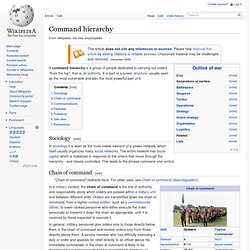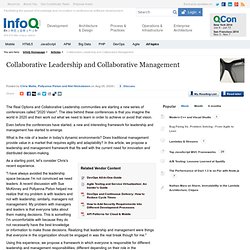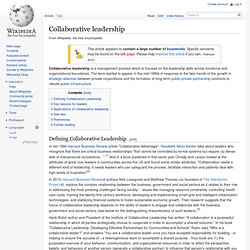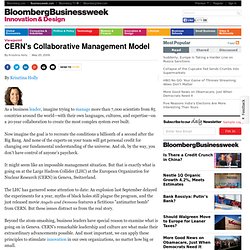

Harte Bretter: In der Energiewende-Demokratie - Harte Bretter. New Terms of use. Following an historic community editing and comment process, Wikimedia’s Terms of Use has been updated.

The newly revised version became effective on May 25, 2012. The updated Terms of Use is the result of a unique collaborative process that incorporated over 200 edits and 4500 lines of discussion. For more than 140 days, the Wikimedia community reviewed, drafted, and redrafted proposed updates to the Terms of Use, resolving over 120 issues. Kollaboratives Schreiben. Command hierarchy. A command hierarchy is a group of people dedicated to carrying out orders "from the top", that is, of authority.

It is part of a power structure: usually seen as the most vulnerable and also the most powerful part of it. Sociology[edit] In sociology it is seen as the most visible element of a power network, which itself usually organizes many social networks. The entire network has social capital which is mobilized in response to the orders that move through the hierarchy - and closely controlled. This leads to the phrase command and control. Chain of command[edit] In a military context, the chain of command is the line of authority and responsibility along which orders are passed within a military unit and between different units. In general, military personnel give orders only to those directly below them in the chain of command and receive orders only from those directly above them. Workplace democracy. Workplace democracy is the application of democracy in all its forms (including voting systems, debates, democratic structuring, due process, adversarial process, systems of appeal) to the workplace.[1] History[edit] Associated with ideologies[edit] Most unions have democratic structures at least for selecting the leader, and sometimes these are seen as providing the only democratic aspects of work.

However, unions are not everywhere, and not every workplace that lacks a union lacks democracy, and not every workplace that has a union necessarily has a democratic way to resolve disputes. However, some unions have historically been more committed to it than others. The best known and most studied example of a successfully democratic national labor union in the United States are the United Electrical, Radio and Machine Workers of America, known throughout the labor movement as the UE.
Studies by management science[edit] Early theory[edit] Relation to political theory[edit] Collaborative Leadership and Collaborative Management. The Real Options and Collaborative Leadership communities are starting a new series of conferences called "2020 Vision".

The idea behind these conferences is that you imagine the world in 2020 and then work out what we need to learn in order to achieve or avoid that vision. Even before the conferences have started, a new and interesting framework for leadership and management has started to emerge. What is the role of a leader in today's dynamic environments? Does traditional management provide value in a market that requires agility and adaptability? In this article, we propose a leadership and management framework that fits well with the current need for innovation and distributed decision-making. As a starting point, let's consider Chris's recent experience.
"I have always avoided the leadership space because I'm not convinced we need leaders. Collaborative leadership. Collaborative leadership is a management practice which is focused on the leadership skills across functional and organizational boundaries.

The term started to appear in the mid-1990s in response to the twin trends of the growth in strategic alliances between private corporations and the formation of long term public private partnership contracts to rebuild public infrastructure. Defining Collaborative Leadership[edit] In her 1994 Harvard Business Review article "Collaborative Advantage", Rosabeth Moss Kanter talks about leaders who recognize that there are critical business relationships "that cannot be controlled by formal systems but require (a) dense web of interpersonal connections…".[1] And in a book published in that same year Chrislip and Larson looked at the attributes of great civic leaders in communities across the US and found some similar attributes.
Key lessons for leaders[edit] Balanced motivations. CERN's Collaborative Management Model. By Krisztina Holly As a business leader, imagine trying to manage more than 7,000 scientists from 85 countries around the world—with their own languages, cultures, and expertise—on a 20-year collaboration to create the most complex system ever built.

Now imagine the goal is to recreate the conditions a billionth of a second after the Big Bang. And none of the experts on your team will get personal credit for changing our fundamental understanding of the universe. And oh, by the way, you don't have control of anyone's paycheck. It might seem like an impossible management situation.